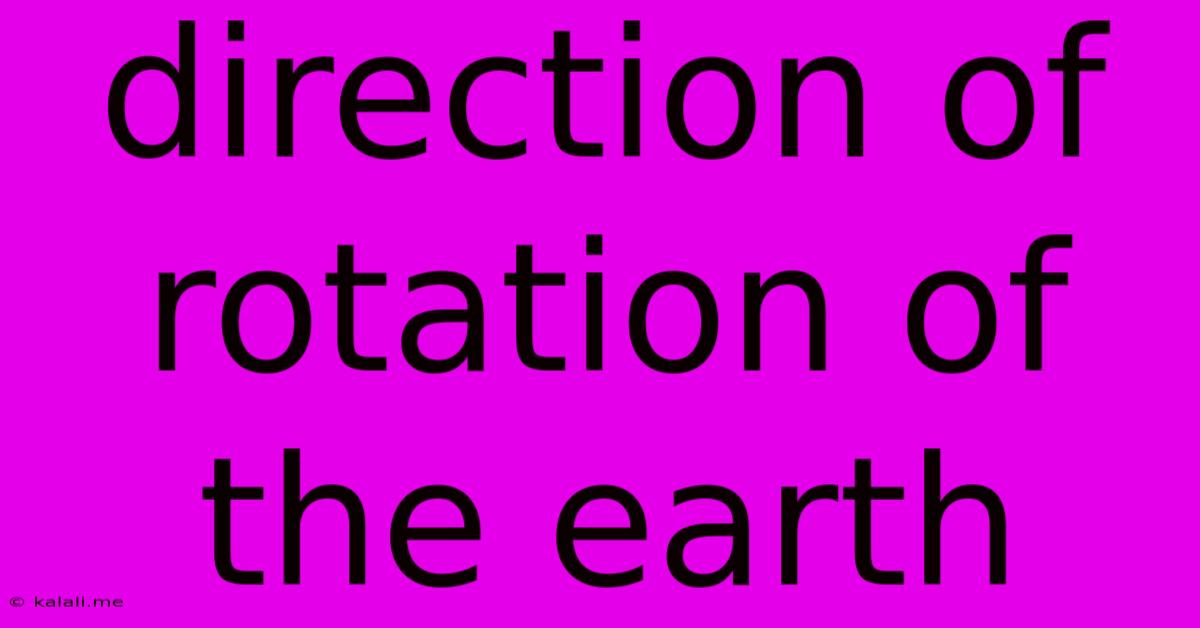Direction Of Rotation Of The Earth
Kalali
May 22, 2025 · 3 min read

Table of Contents
The Earth's Rotation: Direction, Speed, and Effects
The Earth's rotation is a fundamental aspect of our planet, shaping our days, nights, and even the climate. Understanding its direction and speed is crucial to grasping many aspects of our world. This article will explore the Earth's rotation, examining its direction, the speed at which it spins, and the significant effects this rotation has on our planet.
Meta Description: Discover the direction of the Earth's rotation, its speed, and the profound impact it has on our daily lives and the planet's systems. Learn about the Coriolis effect and the implications of this celestial motion.
The Direction of Earth's Rotation: West to East
The Earth rotates on its axis from west to east. This means that if you were looking down at the North Pole, you would see the Earth spinning counter-clockwise. This is why the sun appears to rise in the east and set in the west. This west-to-east rotation is a consistent and fundamental aspect of our planet's movement.
This seemingly simple fact has profound implications. The direction of rotation dictates the direction of prevailing winds, ocean currents, and even the apparent deflection of moving objects (the Coriolis effect).
Speed of Earth's Rotation
The Earth completes one full rotation on its axis approximately every 24 hours. This is why we have a 24-hour day-night cycle. However, it's important to note that this is an average. The Earth's rotation isn't perfectly uniform. Slight variations occur due to several factors including:
- Gravitational influences: The gravitational pull of the moon and the sun cause tidal bulges that subtly affect the Earth's rotation speed.
- Internal processes: Changes within the Earth's core and mantle can also influence the speed of rotation.
- Atmospheric and oceanic currents: The movement of air and water masses can slightly accelerate or decelerate the Earth's spin.
While these variations are relatively small, they are measurable and are tracked by scientists using highly precise atomic clocks and other advanced technologies. These subtle changes have implications for the precise measurement of time and for understanding the dynamic processes occurring within our planet.
Effects of Earth's Rotation
The consequences of the Earth's west-to-east rotation are far-reaching and affect numerous aspects of our planet:
- Day and Night Cycle: The most obvious effect is the alternation of day and night, a fundamental rhythm for all life on Earth. This cycle drives biological processes and influences weather patterns.
- Coriolis Effect: This effect is a crucial consequence of the Earth's rotation. It causes moving objects (like air and water) to be deflected to the right in the Northern Hemisphere and to the left in the Southern Hemisphere. This deflection is responsible for the rotation of large-scale weather systems like hurricanes and cyclones, as well as the direction of ocean currents.
- Tidal Bulges: The Earth's rotation interacts with the gravitational pull of the moon and sun to create tidal bulges in the oceans. These bulges are slightly ahead of the moon's position due to the Earth's rotation, leading to two high tides and two low tides per day in most coastal locations.
- Earth's Shape: The Earth is not a perfect sphere; it's slightly flattened at the poles and bulges at the equator. This oblate spheroid shape is a direct consequence of its rotation. The centrifugal force generated by the rotation pushes outwards at the equator, causing the bulge.
Conclusion
The Earth's rotation, a seemingly simple concept, is a driving force behind numerous planetary processes. Understanding its direction, speed, and consequences is essential to comprehending the complex interactions that shape our world and sustain life as we know it. Further research into the subtle variations in the Earth's rotation continues to reveal more about our planet's dynamic nature.
Latest Posts
Latest Posts
-
Is The Niv A Catholic Bible
May 23, 2025
-
Dnd Reckless Attack And Extra Attack
May 23, 2025
-
Fallout 4 How To Run A Wire
May 23, 2025
-
Use Rope To Reinforce Bunk Bed Frame
May 23, 2025
-
Do Not Meddle In The Affairs Of Dragons
May 23, 2025
Related Post
Thank you for visiting our website which covers about Direction Of Rotation Of The Earth . We hope the information provided has been useful to you. Feel free to contact us if you have any questions or need further assistance. See you next time and don't miss to bookmark.